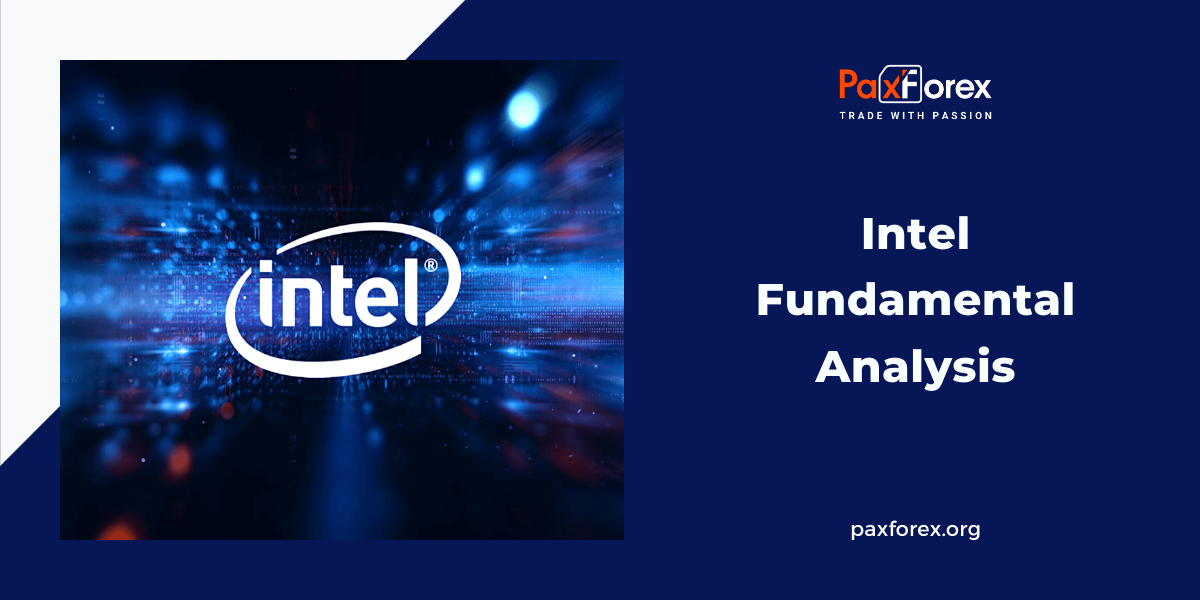
Source: PaxForex Premium Analytics Portal, Fundamental Insight
On April 27, Intel released its Q1 report, revealing a 36% YoY decline in revenue to $11.7 billion. However, the chipmaker managed to surpass analysts' forecasts by $570 million. Although Intel's adjusted net loss of $169 million was significantly lower than its net profit of $3.6 billion from the previous year, its adjusted loss of $0.04 per share still exceeded the consensus forecast by $0.10.
Despite the significant drop in revenue, Intel's stock increased by 4% following the release of the report, indicating that the company exceeded market expectations. However, despite this positive development, the stock is still trading more than 50% lower than its all-time high, which was achieved just over two years ago. Given this information, it begs the question of whether it is now a safe bet to invest in Intel's shares.
In the past decade, Intel, which is still the largest producer of x86 chips for PCs and servers worldwide, has faced a significant challenge to its existence for three reasons.
The first reason is the emergence of Arm-based chips, which posed a threat to the eventual obsolescence of x86 chips. Arm-based chips are more power-efficient, customizable, and better suited for mobile devices than x86 chips.
Intel lagged behind Taiwan Semiconductor Manufacturing and Samsung in the race to create smaller, denser, and more power-efficient chips, while also resisting calls to become a fabless chipmaker like AMD. As a result, AMD surpassed Intel with cheaper and more advanced x86 chips, causing Intel's share of the x86 CPU market to decline from 81.9% to 62.7% between Q1 2017 and Q1 2022, while AMD's share increased almost twice from 18.1% to 34.7%, according to PassMark Software. Intel's decision to invest in upgrading and expanding its foundries resulted in increased expenses and a 65% dividend reduction earlier this year.
Although the pandemic's demand for new PC and data center chips appeared to temporarily mask Intel's underlying challenges, the easing of the pandemic's economic effects resulted in a decline in PC shipments and data center spending. Consequently, Intel's revenue declined year over year for five consecutive quarters, and it has remained unprofitable on an adjusted basis for the past two quarters. Intel's revenue in Q1 primarily came from its client computing group (CCG) which accounts for 50% of its revenue, followed by its data center and AI (DCAI) group at 32%, and the network and edge (NEX) group at 13%. Here's how those three core businesses performed over the past year.
Although Intel's segment revenue continues to decline, there is hope that the worst may be over. For Q2, Intel estimates its revenue to drop by 18% to 25% year over year but rise by nearly 3% sequentially at the midpoint, reaching $11.5 billion to $12.5 billion. This suggests that the first quarter could be the low point of Intel's cyclical downturn.
To address its declining revenue, Intel is divesting its non-core businesses, reducing salaries, and cutting other costs to allocate more resources to its foundries. While its adjusted margins are still decreasing, they may be close to bottoming out in the near future.
Intel is expecting its adjusted gross margin to drop moderately to 37.5% in the next quarter. CFO Dave Zinsner acknowledged that the company's gross margins are still below acceptable levels, but he believes some costs should unwind later this year with the launch of new products.
While CEO Pat Gelsinger believes that Intel is hitting key execution milestones and is confident in the expansion of its foundry business to capitalize on the $1 trillion market opportunity ahead, its stock still appears overvalued at about 60 times forward earnings. Comparatively, AMD and Taiwan Semi trade at 29 and 17 times forward earnings, respectively. Moreover, Intel's reduced forward yield of 2.1% is unlikely to provide much protection against downside risk. Therefore, it might be wise to consider cheaper and more resilient semiconductor stocks, such as Taiwan Semi, instead of investing in Intel's sluggish and expensive turnaround.
As long as the price is above 28.00, follow the recommendations below:
- Time frame: D1
- Recommendation: long position
- Entry point: 29.68
- Take Profit 1: 31.00
- Take Profit 2: 32.50
Alternative scenario:
If the level of 28.00 is broken-down, follow the recommendations below:
- Time frame: D1
- Recommendation: short position
- Entry point: 28.00
- Take Profit 1: 27.00
- Take Profit 2: 25.50













